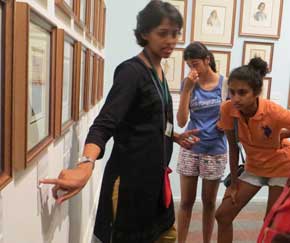Explore the Museum with the
curatorial team every weekend.
Time: Saturday and Sunday
11:30 am English Tour
12:30 pm Hindi/Marathi Tour
Open to all.
Museum ticket applicable.
Closed on Wednesdays.
Note: The weekend public tours are currently suspended due to Covid-19.
Curated by Tasneem Zakaria Mehta
Kamalnayan Bajaj Special Exhibitions Gallery
The exhibition, The Doubled Frame: Interrogating Identity, attempted to trace the genealogy of the Museum's model and diorama collection by exploring the various lenses through which Indians were viewed and were insidiously being taught to view themselves in the 18th, 19th and early 20th centuries. The Museum’s model collection becomes an important and as yet undocumented extension of the ambitious and controversial project to capture in minute detail the people of India. British administrators constructed an archaeology of dominance through visual narratives that ossified and redefined caste and custom and soon Indians learnt to interpret themselves through similar tropes.
The title of this exhibition owes a debt to Dr Homi Bhabha’s seminal text “Location of Culture”. In revisiting history to reflect on how identity shifts and mutates through political and social machinations and creates new visual characteristics and forms of representation, the past inscribes itself in the present, and helps us look afresh at who we are and how we might evolve.
The Dr. Bhau Daji Lad Museum's extraordinary collection of models and dioramas form a unique art historical mode in the larger genre of Company School Painting. They represent more than just a sculptural equivalent of
the paintings. Produced under the tutelage of the Museum's then curators Ernst Fern and C. L. Burns, both of whom were also principals of the Sir J. J. School of Art, the models and dioramas show us how Indians were being
taught to view themselves through the new and exciting medium of the Museum and the various State exhibitions which were popular throughout the latter half of the 19th and early 20th century, to which the Museum regularly
contributed.
The exhibition, The Doubled Frame: Interrogating Identity, attempts to trace the genealogy of our model and diorama collection exploring the various lenses through which Indians were viewed and were insidiously being
taught to view themselves in the 18th, 19th and early 20th centuries. The model collection becomes an important and as yet undocumented extension of the ambitious and controversial project to capture in minute detail
the people of India. British administrators constructed an archaeology of dominance through visual narratives that ossified and redefined caste and custom and soon Indians learnt to interpret themselves through similar
tropes.
In tracing the connections between our models and the various documentary traditions which preceded them in the subcontinent, interesting discoveries have been unearthed which present clearly discernible influences of
artists such as Raja Ravi Varma in the dioramas, The Court of Krishna and Sita in Ashokvan for eg.; or the similarities between our models of Indian communities and the paintings and sketches of Rao Bahadur Durandhar,
an eminent Maharashtrian artist who went on to become the first Indian principal of the Sir J. J. School of Art, Mumbai. The new medium of photography also influenced the way community types were represented in the models
and one can see, for e.g., the Parsi gentleman in our collection derives directly from the studio photograph of Parsis in William Johnson’s The Oriental Races and Tribes, Residents and Visitors of Bombay: A Series of
Photographs with Letterpress Descriptions (1863-66).
The title of this exhibition owes a debt to Dr. Homi Bhabha’s seminal text The Location of Culture (1994). In revisiting history to reflect on how identity shifts and mutates through political and social
machinations and creates new visual characteristics and forms of representation, the past inscribes itself in the present, and helps us look afresh at who we are and how we might evolve.
Exhibition Credits
Curated by Tasneem Zakaria Mehta, Managing Trustee and Honorary Director.
Researched by Madhura Wairkar, Assistant Curator Collections and assisted by Ruta Waghmare.

Curator Tasneem Zakaria Mehta conducted a public walk-through of the exhibition, reflecting on the representation of identity in the colonial documentation of the people of India in the 18th,
19th and early 20th centuries.
Date: Saturday, October 18, 2014

Free and open to all tours of the exhibition in English, Hindi and Marathi were conducted by the Museum’s curatorial team every Saturday and Sunday from September 19 – October 19, 2014.

This workshop encouraged an exploration of the ways in which the people of India were documented in the 18th, 19th and 20th centuries. Turning their gaze to contemporary, urban Mumbai and recalling the popular People of India charts, participants aged 8 and above, drew, decorated and documented the people of the city as they see and encounter them today. Who are Mumbai’s people, and what are their occupations in the 21st century? Who would you show - a movie star, bus conductor, cricketer, dabbawalla or doctor? How would they dress and what props would they hold?
This workshop was offered to schools, for students aged 6 and above, on request throughout the duration of the exhibition.
An open to public session was conducted on Sunday, October 12, 2014.